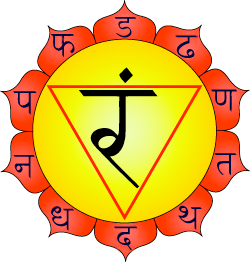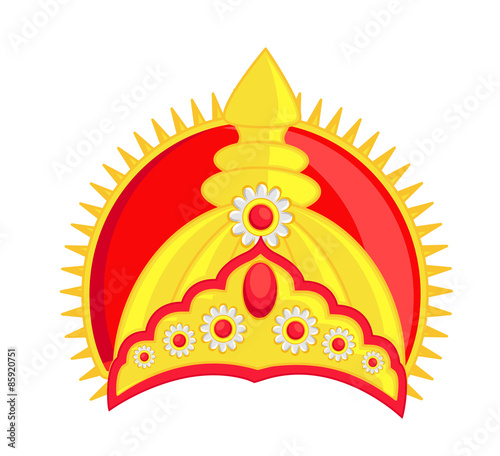
Manipura chakra is shown as having ten petals, bearing the Sanskrit letters ḍa, ḍha, ṇa, ta, tha, da, dha, na, pa, and pha. The seed sound in the centre is ram. The tattwa for the element of Fire is shown (here in outline) as a red triangle.
Manipura (
Sanskrit:
मणिपूर,
IAST:
Maṇipūra, English:
"jewel city") is the third primary
chakra according to Vedic tradition.
Description[edit]
Location[edit]
Located above the
navel[1] or slightly below the
solar plexus, Manipura translates from Sanskrit as the "City of Jewels" (Mani - gem, Pura or Puri - city). Manipura is often associated with the colors
yellow,
[2] blue in classical
tantra,
[3] and
red in the
Nath tradition.
Appearance[edit]
Manipura is represented with a downward-pointing red triangle, signifying the
tattva of fire, within a bright yellow circle, with 10 dark-blue or black petals like heavily laden rain clouds.
The fire region is represented by the god Vahni, who is shining red, has four arms, holds a
rosary and a
spear. Vahni is making the gestures of granting boons, or favors, and dispelling fear. He is seated on a
ram, the animal that represents Manipura.
Seed mantra[edit]

Another representation of manipura. The animal associated to this chakra is the ram.
The seed
mantra is the
syllable 'ram'. Within the
bindu, or dot, above this mantra resides the deity
Rudra. He is red or white, with three eyes, of ancient aspect with a silver beard, and is smeared with white ashes. Rudra makes the gestures of granting boons and dispelling fear and is seated either on a
tiger skin or a
bull.
Rudra's Shakti is the goddess
Lakini. She has a black or dark-blue
vermilion color; has three faces, each with three eyes; and is four-armed. Lakini holds a
thunderbolt, the arrow shot from the bow of
Kama, and fire. She makes the gestures of granting boons and dispelling fear. Lakini is seated on a red
lotus.
The ten
petals of Manipura are dark-blue or black, like heavily laden rain clouds, with the syllables ḍaṁ, ḍhaṁ, ṇaṁ, taṁ, thaṁ, daṁ, dhaṁ, naṁ, paṁ, and phaṁ upon them in a dark-blue color.
Function[edit]
Manipura is considered the center of
dynamism,
energy,
will power (
Itcha shakti), and achievement, which radiates
prana throughout the entire human body. It is associated with the power of fire and digestion, as well as with the sense of sight and the action of movement. Through meditating on Manipura, one is said to attain the power to create (save) or destroy the world.
Association with the body[edit]
The position of Manipura is stated as being either behind the navel or the solar plexus. Sometimes, when it is located at the navel, a secondary chakra called Surya (sun) chakra is located at the solar plexus, whose role is to absorb and assimilate Prana from the sun. Being related to the sense of sight, it is associated with the eyes, and being associated with movement, it is associated with the feet.
[4]
In the
endocrine system, Manipura is said to be associated with the
pancreas and the outer adrenal glands (the
adrenal cortex). These glands create important hormones involved in digestion, converting food into energy for the body, in the same way that Manipura radiates Prana throughout the body.
Practices[edit]
In kundalini and classical
hatha yoga, different practices for arousing and balancing the energies of Manipura include various
asanas. These include
pranayama uddiyana bandha (exhaling and pulling back and up the
abdomen and
diaphragm, respectively); agnisara kriya (practicing
jalandhara bandha, and moving the abdomen in and out);
nauli (stomach churning). Other pranayama and mudra encourage the union of prana and apana, where the lower and higher winds are made to unite.
Comparisons with other systems[edit]
Vajrayana[edit]
In
Vajrayana traditions, the chakra is triangular, red and has 64 petals or channels that extend upwards. This chakra is important as the seat of the 'red drop'. The short syllable 'Ah' is located inside the 'red drop'.
Meditation on 'Ah' is the key component of the practice of
tummo, or inner heat. In tummo, a practitioner's 'subtle winds' are made to enter the central channel, and rise up to its top. This is sometimes compared to 'Raising the kundalini' in Hindu terminology, melting the subtle
white drop in the crown, and causing an experience of great bliss. 'Raising the kundalini' is considered the first and most important of the six
yogas of
Naropa.
[5]
In Chinese
qigong, there are three
Dantians that act as furnaces to convert different energies in the body. The lower Dantian exists in the
stomach region. Its function is to convert
sexual jing energy into
Qi energy (a concept similar to Hindu prana). This is not the location of the lower Dantian.
Lataif-e-sitta[edit]
Within the
Sufi Lataif-e-sitta, the
torso contains several Lataif. Unlike the chakras, the Lataif are not distributed vertically, instead to the left and the right. The
nafs, or lower self, is a centre that is situated below the navel.
Kabbala[edit]
Netzach is the quality of energy to overcome different obstacles.
Hod is the tendency to control and break down energy into different forms, the two forms being contending and balancing forces. This is like the forces of
anabolism and
catabolismin the human body. Hod and Netzach are associated with the left and right legs and feet of the body.
[6]



















